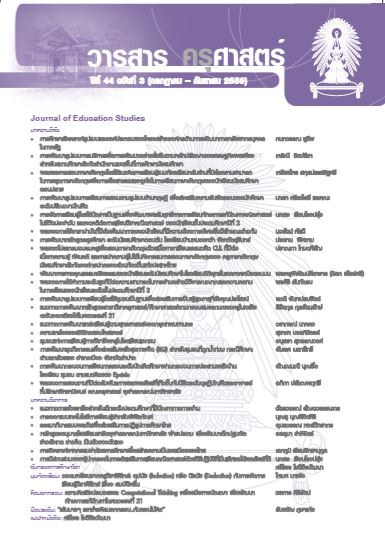ความแกร่งของสถิติทดสอบไคสแควร์ Robustness of the Chi-square Test
Keywords:
สถิติทดสอบไคสแควร์, ความแกร่ง, อัตราความคลาดเคลื่อนประเภทที่ 1, CHI-SQUARE TEST STATISTIC, ROBUSTNESS, TYRE I ERROR RATEAbstract
งานวิจัยนี้มีวัตถุประสงค์เพื่อตรวจสอบความคลาดเคลื่อนประเภทที่ 1 ของสถิติทดสอบไคสแควร์แบบเพียร์สัน ผลการวิจัยนำเสนอว่าภายใต้สถานการณ์ใดบ้างที่เพียร์สันไคสแควร์มีความแกร่งสำหรับการทดสอบความเป็นอิสระของตัวแปร 2 ตัว งานวิจัยนี้ใช้การจำลองข้อมูลแบบยูนิฟอร์มที่มีค่าระหว่าง 0 และ 1 จากโปรแกรม SAS ในแต่ละเงื่อนไขใช้นัยสำคัญ 3 ระดับคือ .01, .05, .10 ตัวอย่าง 4 ขนาดคือ 20, 50, 100, 300 สำหรับตารางขนาด 2x2, 2x4, 2x5, 4x5 (เฉพาะขนาดตัวอย่าง 100 และ 300) ข้อมูลมีการแจกแจงแบบยูนิฟอร์มจนถึงเบ้มาก แต่ละเงื่อนไขวิเคราะห์ซ้ำ 10,000 ตัวอย่าง ผลการวิจัยสรุปได้ดังนี้
1. เพียร์สันไคสแควร์มีความแกร่งเมื่อข้อมูลมีค่า eij<5 ไม่เกิน 60% และไม่มีค่าใดต่ำกว่า 1
2. เพียร์สันไคสแควร์มีแนวโน้ม ยากต่อการปฏิเสธสมมติฐานหลัก (conservative) เมื่อข้อมูลมีค่า eij<5 เกินกว่า 60% และไม่มีค่าใดต่ำกว่า 1
3. เพียร์สันไคสแควร์มีแนวโน้มไม่คงเส้นคงวา (inconsistent) เมื่อข้อมูลมีค่า eij<5 เกินกว่า 60% และมีบางค่าต่ำกว่า 1 ส่วนใหญ่จะมีแนวโน้มง่ายต่อการปฏิเสธสมมติฐานหลัก (liberal) แต่มีบางกรณีที่ยากต่อการปฏิเสธสมมติฐานหลัก (conservative) ในกรณีนี้ไม่แนะนำให้ใช้สถิติทดสอบเพียร์สันไคสแควร์
The purpose of the current study is to investigate the Type I error rates of the Pearson Chi-square statistic. Results of the study provide recommendations regarding under what conditions the Pearson Chi-square test of independence is robust. For this Monte Carlo study, the data were created using SAS UNIFORM to generate uniform random numbers on the interval from zero to one. For the true null hypotheses, each condition, three significance levels (.01, .05, .10), four sample sizes (20, 50, 100, 300) for 2 x 2, 2 x 4, and 2 x 5 and two sample sizes (100, 300) for 4 x 5 contingency tables were investigated. Three marginal probability distributions ranging from uniform to highly skewed on both rows and columns for each 2 x 2, 2 x 4, and 2 x 5 table and five marginal probability distributions for each 4 x 5 table were examined. For each condition, 10,000 samples were repeated. Simulation results show that the Pearson Chi-square is robust with respect to Type I error rates, the recommendations on the use of Pearson Chi-square are:(a) the Pearson Chi-square is robust in a sparse table (a table with less than 60% of the eij less than five and none of them less than one). The empirical Type I error rates of the Pearson Chi-square lie within the two standard error range, (b) the Pearson Chi-square tends to be conservative in a moderately sparse table (a table with more than 60% of the eij less than five and none of them less than one), and (c) the Pearson Chi-square tends to be too liberal and is not recommended in an extremely sparse table (a table with a large variation in the eij and more than 60% of the eij less than five and some of them less than one). Therefore, Pearson Chi-square is robust and recommended for a table with less than 60% of eij <5 and none of them less than one.



